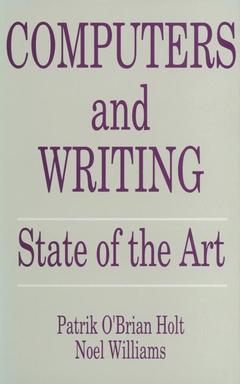Description
Computers and Writing, 1992
State of the Art
Coordinators: O'Brian Holt Patrik, Williams Noel
Language: English
Publication date: 04-2014
387 p. · 15.5x23.5 cm · Paperback
387 p. · 15.5x23.5 cm · Paperback
Description
/li>Contents
/li>
Patrik O'Brian Holt Heriot-Watt University After speech, writing is the most common form of human communication and represents the cornerstone of our ability to preserve and record information. Writing, by its very definition, requires artifacts in the form of tools to write with and a medium to write on. Through history these artifacts have ranged from sticks and clay tablets, feather and leather, crude pens and paper, sophisticated pens and paper, typewriters and paper; and electronic devices with or without paper. The development of writing tools has straightforward objectives, to make writing easier and more effective and assist in distributing written communication fast and efficiently. Both the crudest and most sophisticated forms of writing tools act as mediators of human written communication for the purpose of producing, distributing and conserving written language. In the modern world the computer is arguably the most sophisticated form of mediation, the implications of which are not yet fully understood. The use of computers (a writing artifact which mediates communication) for the production and editing of text is almost as old as computers themselves. Early computers involved the use of crude text editors and a writer had to insert commands resembling a programming language to format and print a document. For example to underline a word the writer had to do the following, This is an example of how to .ul underline a single word. in order to produce: This is an example of how to underline a single word.
Preface; P. O'Brian Holt. 1. New Technology, New Writing, New Problems? N. Williams. 2. Three Modes of Collaborative Authoring; J. Newman, R. Newman. 3. Is There a Reader in this Labyrinth? Notes on Reading Afternoon; J. Yellowlees Douglas. 4. Narrative Computer Systems: The Dialectics of Emotion and Formalism; P. Bøgh Andersen, B. Holmqvist. 5. A Language-Sensitive Text Editor for Dutch; G. Kempen, T. Vosse. 6. Boxweb: A Structured Outline Program for Writers; P. Wayner. 7. An Author's Cross-Referencer; H. Thimbleby. 8. Text to Hypertext and Back Again; C. Ghaoui, S.M. George, R. Rada, M. Beer, J. Getta. 9. Word Frequency Based Indexing and Authoring; M. Mhashi, R. Rada, H. Mili, Geeng-Neng You, A. Zeb, A. Michailidis. 10. Text Indexing: The Problem of Significance; C. Korycinski, A.F. Newell. 11. Factors Affecting Organisational Acceptance of an Automated Writing Aid; A.E. Winterbauer. 12. Supporting Writing with an Undo Mechanism; Yiya Yang. 13. Internationalisation: The Programer, the User and the Writer; L.F. Marshall. 14. Controlled English (CE): From COGRAM to ALCOGRAM; D. Schreurs, G. Adriaens. 15. Action Centred Manuals or Minimalist Instruction? Alternative Theories for Carroll's Minimal Manuals; S.W. Draper, K. Oatley. 16. A Dictionary View of Technical Writing; A. Kukulska-Hulme. 17. Textbase Technology: Writing with Reusable Text; R.A. Buchanan. 18. A Hypertext-Based Support Aid for Writing Software Documentation; G.Born. 19. An Automated Grammar and Style Checker for Writers of Simplified English; J.E. Hoard, R. Wojcik, K. Holzhauser. 20. Ruskin to McRuskin -- Degrees of Interaction; S. McGowan. 21. Representing Writing: External Representations and the Writing Process; M. Sharples, L. Pemberton. 22. The CONST-Project: Computer Instructed Writing Techniques; J. Beeken, G. Geerts, W. van Belle. 23. `IV Storybase': Using Interactive Video to Develop Creative Writing Skills; R. McLeod. 24. Story Building with Computers: Effects on Reading Comprehension, Vocabulary, Attitude and Writing; D. Little.
© 2024 LAVOISIER S.A.S.


